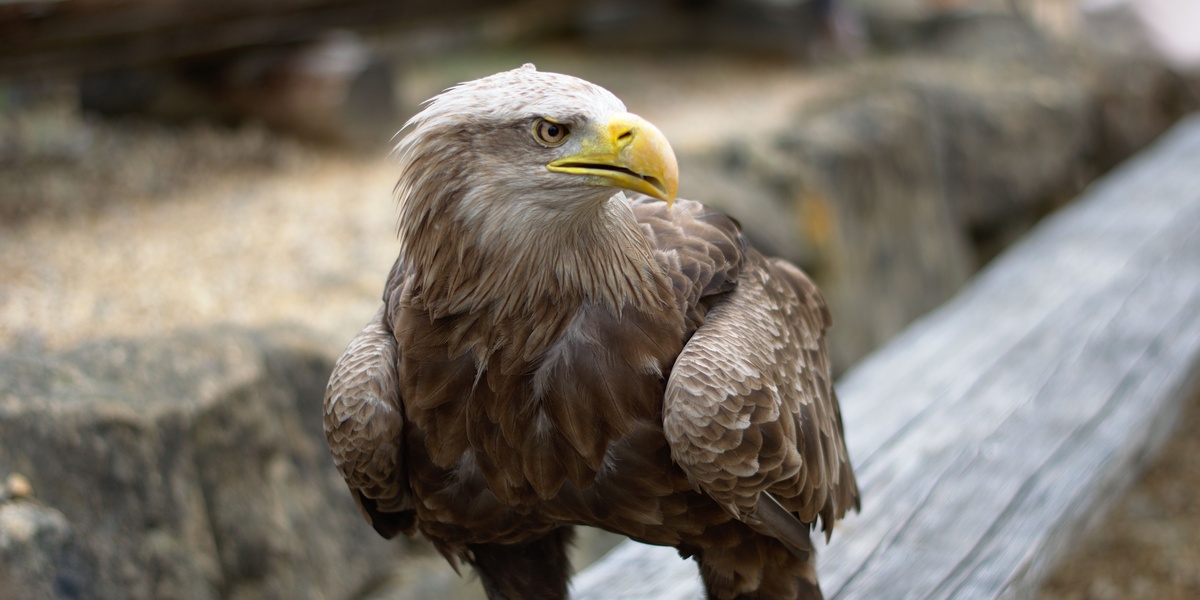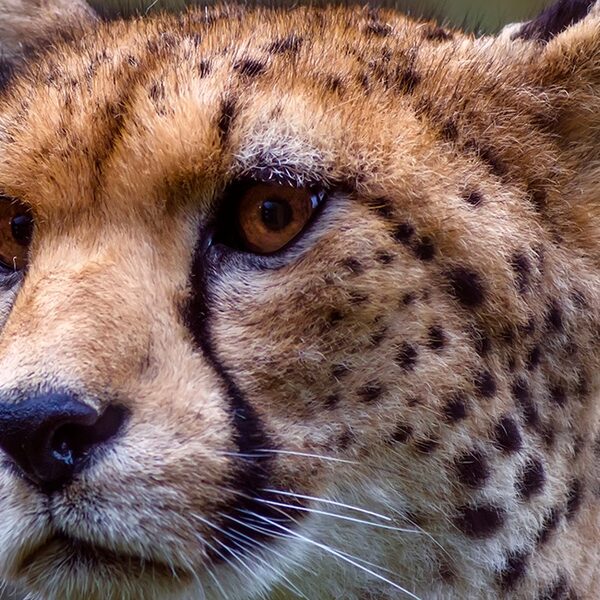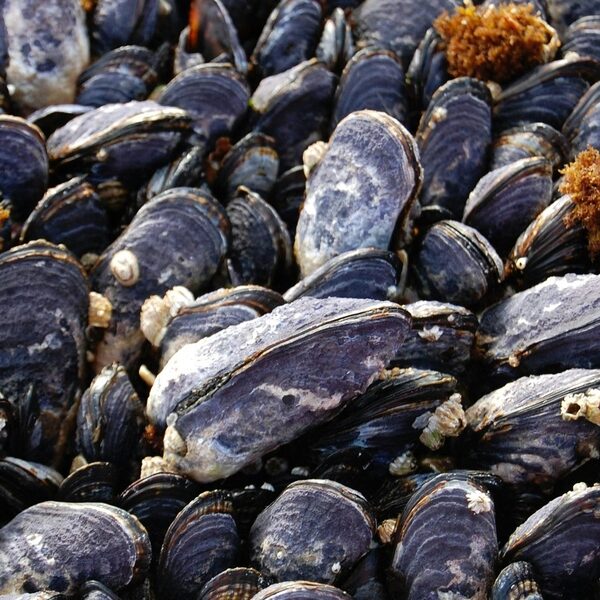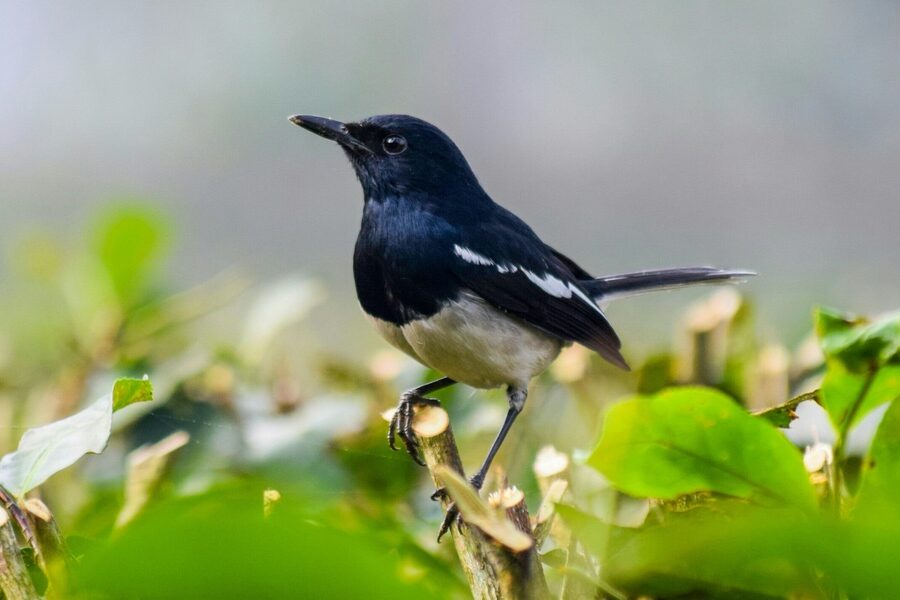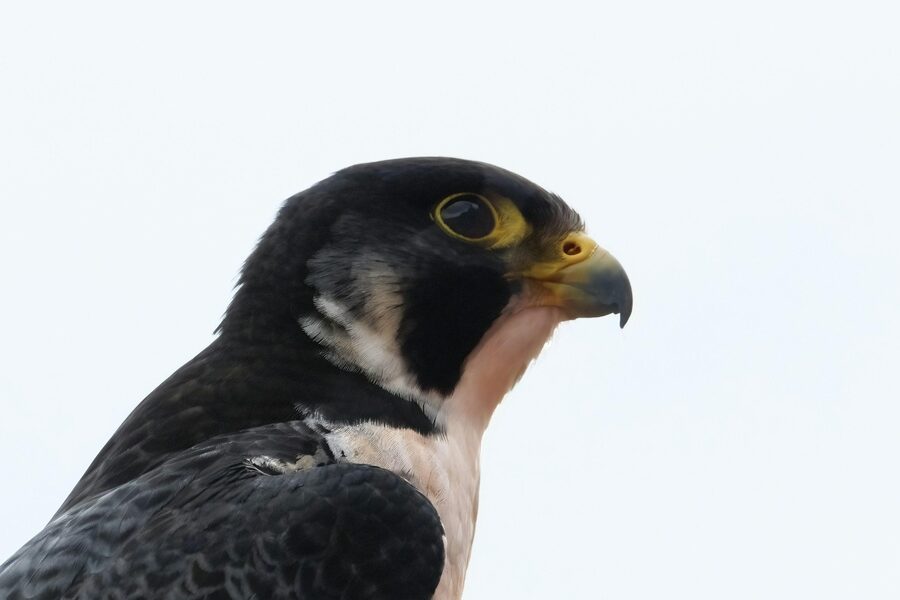Sweden’s coastline, wetlands and forests host a wide range of birdlife, from sea-dwelling species to inland passerines and Arctic breeders. Whether you’re walking a coastal trail or scanning a reedbed, the country’s habitats make for reliable and varied sightings.
There are 102 Birds of Sweden, ranging from Arctic Tern to Wood Sandpiper. For each species, you’ll find below the Scientific name, Status & range and Length (cm), you’ll find below.
When is the best time to spot different birds across Sweden?
Spring and autumn migrations are peak times for diversity as many species pass through or arrive to breed, while summer highlights breeding birds—especially in the north—and winter offers chances for sea ducks and hardy residents; check the Status & range for timing and regional presence.
How can I use the table to plan a birdwatching trip?
Use the Scientific name to match field guides and apps, consult Status & range to target likely locations and seasons, and glance at Length (cm) to help with size comparisons in the field; combine that info with local reserve reports and recent sightings for practical planning.
Birds of Sweden
| Common name | Scientific name | Status & range | Length (cm) |
|---|---|---|---|
| Mute Swan | Cygnus olor | Common resident breeder in southern and central Sweden; expanding north. | 150 |
| Whooper Swan | Cygnus cygnus | Common migrant and winter visitor; breeds in northern wetlands and taiga. | 150 |
| Tundra Swan | Cygnus columbianus | Scarce migrant and winter visitor, mainly in southern Sweden. | 120 |
| Greylag Goose | Anser anser | Very common breeder throughout southern and central Sweden, also a numerous migrant. | 82 |
| Greater White-fronted Goose | Anser albifrons | Common migrant and winter visitor, mainly in southern Sweden. | 72 |
| Barnacle Goose | Branta leucopsis | Common migrant and winter visitor; breeding populations established on Baltic islands. | 64 |
| Canada Goose | Branta canadensis | Very common introduced resident breeder throughout southern and central Sweden. | 95 |
| Common Shelduck | Tadorna tadorna | Common breeder along the coasts of southern and central Sweden. | 61 |
| Mallard | Anas platyrhynchos | Very common resident breeder and migrant throughout Sweden. | 58 |
| Eurasian Teal | Anas crecca | Common and widespread breeder in wetlands throughout Sweden. | 36 |
| Common Pochard | Aythya ferina | Fairly common breeder in nutrient-rich lakes in southern and central Sweden. | 46 |
| Tufted Duck | Aythya fuligula | Common breeder in lakes and coastal waters throughout most of Sweden. | 43 |
| Common Eider | Somateria mollissima | Common breeder along all of Sweden’s coasts. | 65 |
| Common Goldeneye | Bucephala clangula | Common breeder in lakes and rivers in forested areas throughout Sweden. | 46 |
| Goosander | Mergus merganser | Common breeder in lakes and rivers throughout Sweden. | 62 |
| Red-breasted Merganser | Mergus serrator | Common breeder along coasts and in northern lakes and rivers. | 55 |
| Hazel Grouse | Tetrastes bonasia | Fairly common resident in dense, mixed forests throughout most of Sweden. | 36 |
| Willow Ptarmigan | Lagopus lagopus | Common resident in mountain birch forests and heathlands in the north. | 38 |
| Western Capercaillie | Tetrao urogallus | Fairly common resident in old pine forests throughout most of Sweden. | 70 |
| Black Grouse | Lyrurus tetrix | Common resident in open woodlands, moorlands, and forest edges across Sweden. | 53 |
| Grey Partridge | Perdix perdix | Uncommon introduced resident in open farmland in southernmost Sweden. | 30 |
| Common Pheasant | Phasianus colchicus | Common introduced resident in farmland and open woods in southern Sweden. | 70 |
| Great Crested Grebe | Podiceps cristatus | Common breeder in lakes and reservoirs in southern and central Sweden. | 49 |
| Great Cormorant | Phalacrocorax carbo | Common breeder in coastal and inland colonies throughout southern Sweden. | 90 |
| Eurasian Bittern | Botaurus stellaris | Scarce breeder in large reedbeds in southern and central Sweden. | 75 |
| Grey Heron | Ardea cinerea | Common breeder in southern and central Sweden, found near various wetlands. | 94 |
| White Stork | Ciconia ciconia | Scarce and local breeder in southernmost Sweden, mainly Scania. | 101 |
| Osprey | Pandion haliaetus | Fairly common summer breeder near lakes and coasts throughout Sweden. | 58 |
| European Honey Buzzard | Pernis apivorus | Fairly common summer breeder in forests throughout most of Sweden. | 56 |
| White-tailed Eagle | Haliaeetus albicilla | Widespread resident breeder along coasts and large lakes throughout Sweden. | 84 |
| Hen Harrier | Circus cyaneus | Fairly common breeder in moorlands, heathlands, and young forests. | 48 |
| Eurasian Sparrowhawk | Accipiter nisus | Common breeder in woodlands and gardens throughout Sweden. | 33 |
| Northern Goshawk | Accipiter gentilis | Fairly common but secretive resident breeder in mature forests throughout Sweden. | 54 |
| Common Buzzard | Buteo buteo | Very common breeder in open woodlands and farmland throughout most of Sweden. | 54 |
| Golden Eagle | Aquila chrysaetos | Scarce resident breeder in mountains and remote forests, mainly in the north. | 82 |
| Common Kestrel | Falco tinnunculus | Fairly common breeder in open country, farmland, and cities across Sweden. | 34 |
| Merlin | Falco columbarius | Fairly common breeder in northern moors and bogs; migrant elsewhere. | 28 |
| Peregrine Falcon | Falco peregrinus | Scarce but widespread breeder on cliffs, bogs, and tall buildings. | 45 |
| Water Rail | Rallus aquaticus | Fairly common but very secretive breeder in reedbeds in southern Sweden. | 25 |
| Common Moorhen | Gallinula chloropus | Common breeder in ponds and wetlands with vegetation in southern Sweden. | 33 |
| Eurasian Coot | Fulica atra | Very common breeder in lakes and ponds in southern and central Sweden. | 38 |
| Common Crane | Grus grus | Common breeder in bogs and wetlands across Sweden; spectacular migrant. | 115 |
| Eurasian Oystercatcher | Haematopus ostralegus | Common breeder along coasts and, increasingly, inland lakes and fields. | 43 |
| Northern Lapwing | Vanellus vanellus | Common breeder on farmland and wetlands in southern and central Sweden. | 30 |
| Eurasian Golden Plover | Pluvialis apricaria | Common breeder on moorlands and heathlands in the north and central regions. | 27 |
| Ringed Plover | Charadrius hiaticula | Common breeder on sandy and shingly coasts and shores throughout Sweden. | 19 |
| Eurasian Woodcock | Scolopax rusticola | Common breeder in damp woodlands throughout most of Sweden. | 34 |
| Common Snipe | Gallinago gallinago | Common and widespread breeder in bogs, marshes, and wet meadows. | 26 |
| Eurasian Curlew | Numenius arquata | Fairly common breeder in moorlands, bogs, and farmland. | 55 |
| Common Sandpiper | Actitis hypoleucos | Common breeder along stony lakeshores and rivers throughout Sweden. | 20 |
| Common Redshank | Tringa totanus | Common breeder in coastal meadows and inland marshes, mainly in the south. | 28 |
| Wood Sandpiper | Tringa glareola | Common breeder in bogs and marshy woodlands, especially in the north. | 21 |
| Black-headed Gull | Chroicocephalus ridibundus | Very common breeder in colonies near coasts and lakes in southern Sweden. | 39 |
| Common Gull | Larus canus | Common and widespread breeder near water, both coastal and inland. | 43 |
| Herring Gull | Larus argentatus | Common breeder along coasts and some large inland lakes. | 61 |
| Great Black-backed Gull | Larus marinus | Common resident breeder along all of Sweden’s coasts. | 71 |
| Common Tern | Sterna hirundo | Common breeder in colonies on coastal islands and inland lakes. | 35 |
| Arctic Tern | Sterna paradisaea | Common breeder, mainly along coasts and in northern mountain lakes. | 35 |
| Razorbill | Alca torda | Common breeder in large colonies on coastal cliffs and islands. | 41 |
| Common Guillemot | Uria aalge | Common breeder in dense colonies on steep coastal cliffs, mainly in the Baltic. | 42 |
| Black Guillemot | Cepphus grylle | Fairly common breeder on rocky coasts and islands. | 33 |
| Rock Dove / Feral Pigeon | Columba livia | Very common resident in cities, towns, and farmland throughout Sweden. | 33 |
| Stock Dove | Columba oenas | Fairly common breeder in parks and open woodland in southern Sweden. | 33 |
| Common Wood Pigeon | Columba palumbus | Very common and widespread breeder in all kinds of wooded habitats. | 42 |
| Eurasian Collared Dove | Streptopelia decaocto | Common breeder in towns and villages in southern and central Sweden. | 32 |
| European Turtle Dove | Streptopelia turtur | Rare and declining summer breeder in open woodlands in southernmost Sweden. | 27 |
| Common Cuckoo | Cuculus canorus | Fairly common summer breeder in a variety of habitats across Sweden. | 33 |
| Barn Owl | Tyto alba | Very rare breeder in open farmland in southernmost Sweden. | 34 |
| Tawny Owl | Strix aluco | The most common owl, resident in woodlands and parks in southern Sweden. | 38 |
| Ural Owl | Strix uralensis | Fairly common resident in old coniferous and mixed forests in central Sweden. | 60 |
| Great Grey Owl | Strix nebulosa | Scarce and elusive resident of deep, remote taiga forests in the north. | 67 |
| Eurasian Pygmy Owl | Glaucidium passerinum | Fairly common but secretive resident in coniferous forests. | 17 |
| Boreal (Tengmalm’s) Owl | Aegolius funereus | Fairly common resident in coniferous forests throughout most of Sweden. | 25 |
| Long-eared Owl | Asio otus | Fairly common breeder in woodlands and farmland across much of Sweden. | 36 |
| Short-eared Owl | Asio flammeus | Breeder in open moorland and bogs; numbers fluctuate with vole cycles. | 38 |
| European Nightjar | Caprimulgus europaeus | Fairly common summer breeder on heathlands and in clear-cuts. | 27 |
| Common Swift | Apus apus | Common summer breeder in towns and cities across most of Sweden. | 17 |
| Common Kingfisher | Alcedo atthis | Scarce breeder along clear, slow-moving rivers in southern Sweden. | 16 |
| Great Spotted Woodpecker | Dendrocopos major | Very common and widespread resident in all types of woodland. | 23 |
| Lesser Spotted Woodpecker | Dryobates minor | Scarce and declining resident in deciduous woodlands, mainly in the south. | 15 |
| Black Woodpecker | Dryocopus martius | Fairly common resident in mature coniferous and mixed forests. | 46 |
| Eurasian Green Woodpecker | Picus viridis | Fairly common resident in open woodlands and parklands in southern Sweden. | 32 |
| Eurasian Wryneck | Jynx torquilla | Fairly common summer breeder in open woodlands and farmland. | 17 |
| Barn Swallow | Hirundo rustica | Very common summer breeder throughout Sweden, especially in rural areas. | 18 |
| House Martin | Delichon urbicum | Common summer breeder in towns, villages, and cliffs across Sweden. | 13 |
| Meadow Pipit | Anthus pratensis | Very common breeder in open habitats like moorland, heath, and meadows. | 15 |
| White Wagtail | Motacilla alba | Very common and widespread summer breeder in open and urban habitats. | 18 |
| Bohemian Waxwing | Bombycilla garrulus | Breeds in northern taiga; irruptive winter visitor to the south. | 19 |
| Winter Wren | Troglodytes troglodytes | Common breeder in woodlands and dense cover throughout Sweden. | 10 |
| Dunnock | Prunella modularis | Common breeder in woodland, parks, and gardens across most of Sweden. | 15 |
| Eurasian Robin | Erithacus rubecula | Very common breeder in woodlands and gardens throughout most of Sweden. | 14 |
| Thrush Nightingale | Luscinia luscinia | Fairly common summer breeder in damp thickets and waterside scrub in the south. | 17 |
| Common Redstart | Phoenicurus phoenicurus | Common summer breeder in open woodlands, parks, and gardens. | 14 |
| Northern Wheatear | Oenanthe oenanthe | Common breeder in open, rocky or sparsely vegetated habitats. | 15 |
| Whinchat | Saxicola rubetra | Fairly common summer breeder in damp meadows and open grasslands. | 13 |
| Song Thrush | Turdus philomelos | Common breeder in woodlands, parks, and gardens throughout most of Sweden. | 23 |
| Redwing | Turdus iliacus | Common breeder in birch and mixed forests, especially in the north. | 21 |
| Fieldfare | Turdus pilaris | Very common breeder in open woodland and parks across the entire country. | 26 |
| Eurasian Blackbird | Turdus merula | Very common and widespread breeder in woodlands, parks, and gardens. | 25 |
| Garden Warbler | Sylvia borin | Common summer breeder in woodlands with dense undergrowth. | 14 |
| Eurasian Blackcap | Sylvia atricapilla | Very common summer breeder in woodlands, parks, and gardens. | 14 |
| Common Whitethroat | Curruca communis | Common summer breeder in scrubland, hedgerows, and open woodland. | 14 |
Images and Descriptions
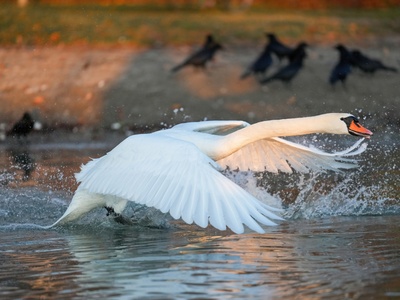
Mute Swan
This familiar, graceful white swan is recognized by its bright orange bill with a black knob at the base. It’s often seen on lakes, ponds, and placid coastal waters, known for its elegant posture and surprisingly powerful hisses when threatened.
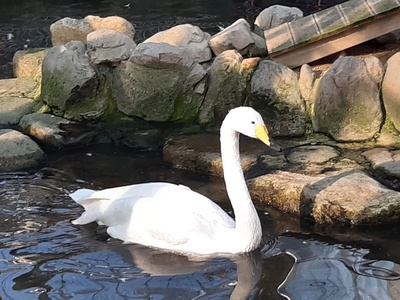
Whooper Swan
A large, elegant white swan with a long, straight neck and a distinctive wedge-shaped yellow and black bill. Its loud, bugling call is a classic sound of northern wetlands, often heard as large flocks migrate across the country in spring and autumn.
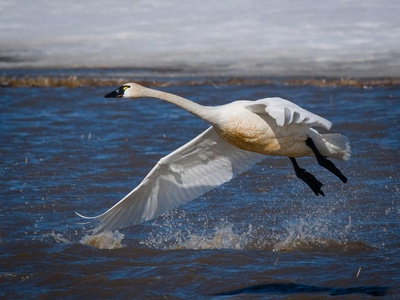
Tundra Swan
Slightly smaller than the Whooper Swan, this species has a smaller yellow patch on its bill that doesn’t extend to the nostril. It is an uncommon visitor, usually seen mixed in with flocks of other swans during migration seasons.
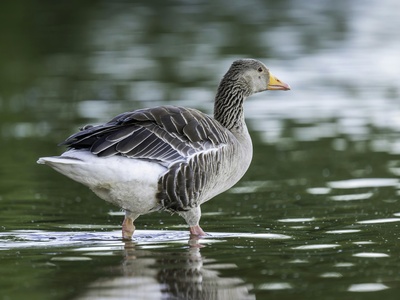
Greylag Goose
The ancestor of most domestic geese, this large, bulky goose has a stout pinkish-orange bill and pink legs. Its loud, honking calls are a common sound in wetlands, agricultural fields, and even urban parks, especially during migration.
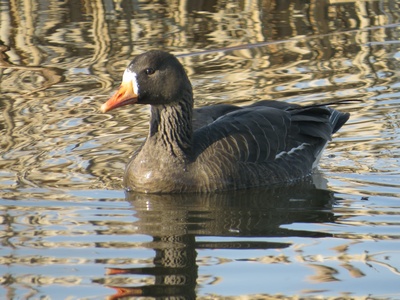
Greater White-fronted Goose
A medium-sized grey-brown goose with a distinctive white patch at the base of its pink bill and black bars on its belly. It travels in large, noisy flocks, stopping to feed in agricultural fields and wetlands during its long migration.
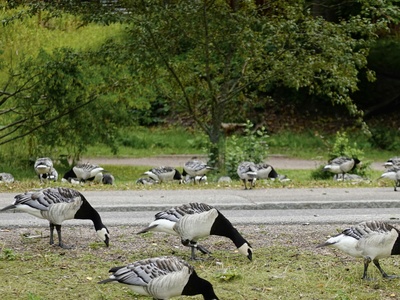
Barnacle Goose
A striking, medium-sized goose with a creamy-white face, black neck and breast, and a grey barred body. Originally just a migrant, it now has a thriving breeding population, especially on Gotland and along the Baltic coast, forming huge, noisy flocks.
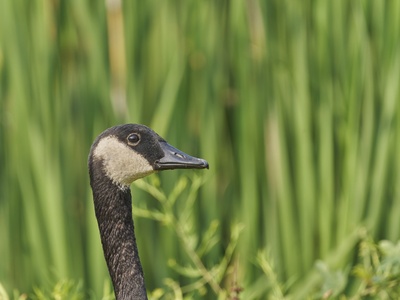
Canada Goose
A large, familiar goose with a long black neck, white “chinstrap,” and a brownish-grey body. Originally introduced from North America, it is now one of Sweden’s most common and widespread waterfowl, found in parks, lakes, and farmland.
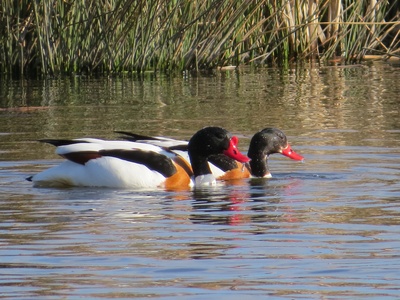
Common Shelduck
A large, brightly patterned goose-like duck. It has a dark green head, white body, a broad chestnut band across its chest, and a bright red bill. This striking bird is a common sight in coastal mudflats, estuaries, and shallow bays.
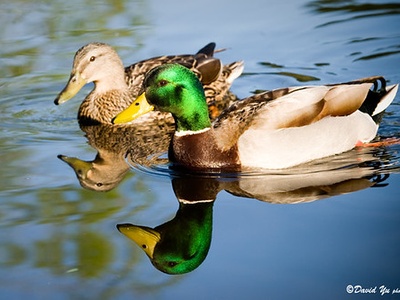
Mallard
The most familiar duck in Sweden, found in almost any wetland habitat. The male has an iridescent green head, yellow bill, and curled black tail feathers, while the female is a mottled brown. They are highly adaptable and often quite tame.
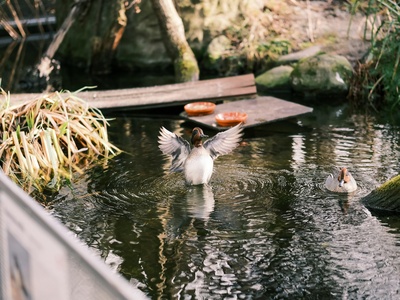
Eurasian Teal
Sweden’s smallest duck, the male is beautifully patterned with a chestnut head, a broad green eye-patch, and a grey body. They are fast, agile fliers, often seen in tight flocks. A common sight in marshes, shallow lakes, and flooded meadows.
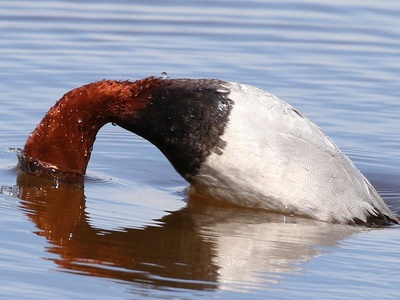
Common Pochard
A medium-sized diving duck with a distinctive sloping forehead. The male has a rusty-red head, black breast, and a pale grey body. It often gathers in flocks on open water, diving to feed on aquatic plants and invertebrates.
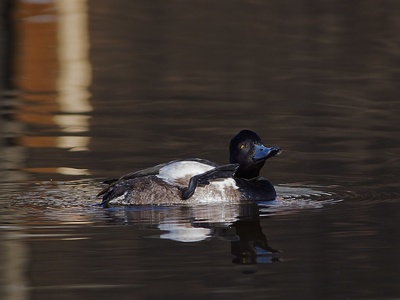
Tufted Duck
A compact diving duck easily identified by the male’s namesake long tuft of feathers on his head. He is a striking black and white, while the female is a chocolate brown. They are sociable birds, often forming large rafts on open water.
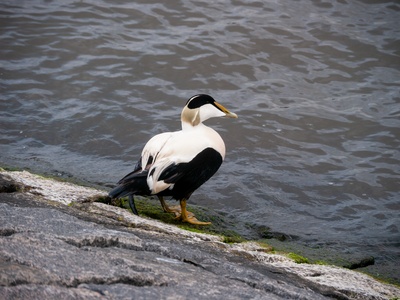
Common Eider
A large, heavy sea duck famous for its incredibly warm down feathers. The male is a spectacular black and white with a pale green nape and a unique, sloping, olive-green bill. It’s a true marine species, rarely seen far from the coast.
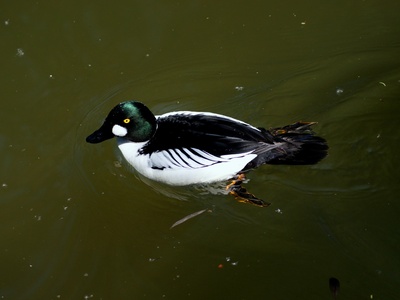
Common Goldeneye
A medium-sized diving duck named for its bright yellow eye. The male is a crisp black and white with a glossy, dark green-purplish head. They are cavity nesters, often using nest boxes, and their wings make a distinctive whistling sound in flight.
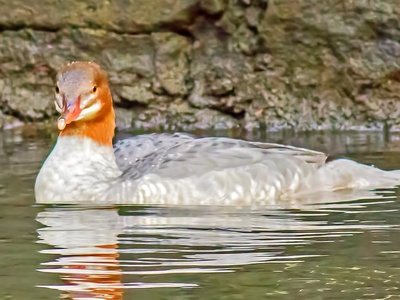
Goosander
A large, long-bodied diving duck with a slender, serrated bill for catching fish. The male is pristine white and black with a dark green head, while the female has a shaggy, reddish-brown crest. Often seen in fast-flowing rivers or clear lakes.
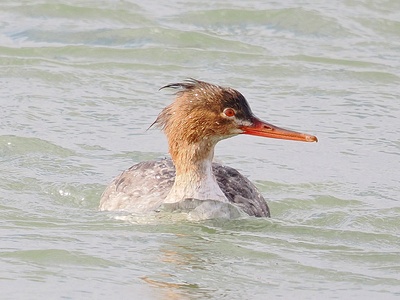
Red-breasted Merganser
Slightly smaller and more slender than the Goosander, this fish-eating duck is recognized by the male’s wispy, double crest and streaked breast band. It’s primarily a coastal breeder but is also found on large, clear lakes in the north.
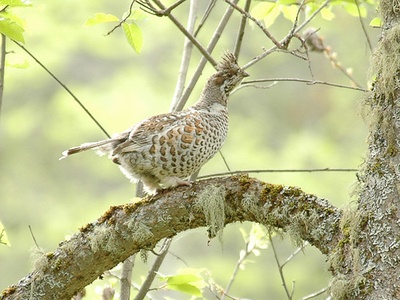
Hazel Grouse
A small, secretive grouse that is more often heard than seen. It has intricately patterned grey, brown, and white plumage, providing excellent camouflage in the forest undergrowth. Its high-pitched, whistling call is a characteristic sound of the taiga forest.
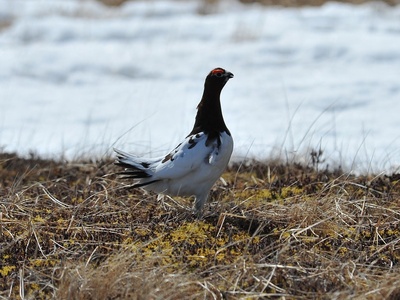
Willow Ptarmigan
A medium-sized grouse perfectly adapted to alpine environments. Its plumage changes seasonally, from mottled brown in summer to pure white in winter for camouflage. It is known for its bizarre, croaking calls, especially during spring courtship displays.
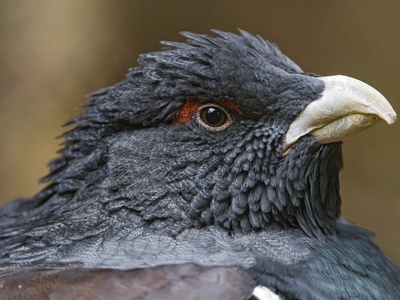
Western Capercaillie
Europe’s largest grouse, the male is a magnificent, turkey-sized bird with dark, iridescent plumage. Famous for its spectacular lekking display in spring, where males gather to perform a strange sequence of clicks, pops, and gurgling sounds to attract females.
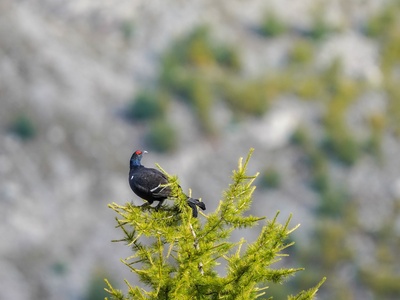
Black Grouse
The male is a striking, glossy black bird with a lyre-shaped tail and bright red “eyebrows” (wattles). In spring, males gather at traditional display grounds called leks, where they posture, bubble, and hiss to compete for mates.
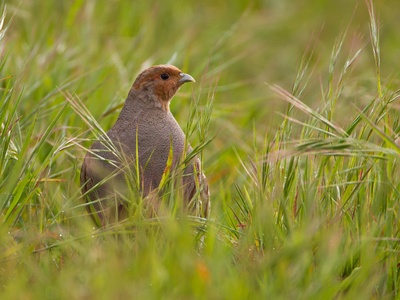
Grey Partridge
A small, rotund gamebird with a subtly patterned grey and brown body and a distinctive orange-brown face. It is typically found in small groups, or coveys, in agricultural landscapes, where it forages for seeds and insects on the ground.
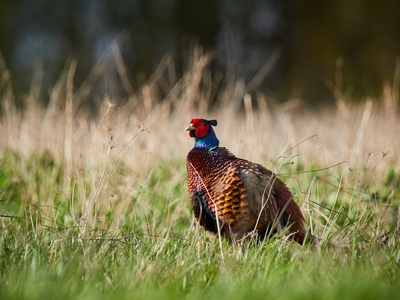
Common Pheasant
A large, long-tailed gamebird, originally from Asia. The male is incredibly colorful, with iridescent copper and gold plumage, a green head, and red facial wattles. Its harsh, crowing call is a familiar sound in the countryside.
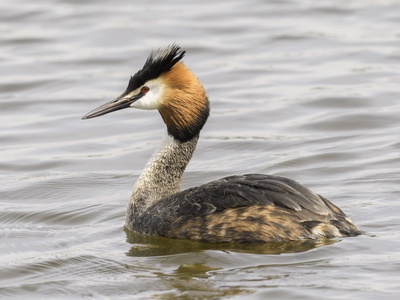
Great Crested Grebe
An elegant waterbird known for its elaborate courtship dance, where pairs mirror each other’s movements. It has a slender neck and a striking head plume in summer. It’s an expert diver, hunting for fish beneath the surface of the water.
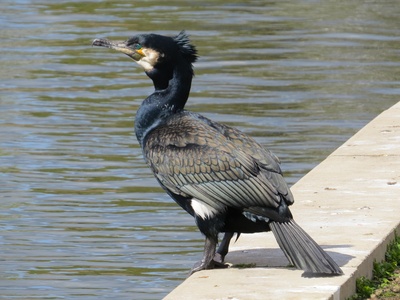
Great Cormorant
A large, dark waterbird with a long, hooked bill, often seen perched with its wings spread out to dry. An efficient fish-eater, its growing population has sometimes brought it into conflict with fishing interests. They nest in noisy, crowded colonies.
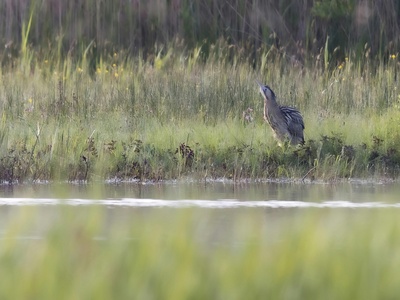
Eurasian Bittern
A secretive, stocky heron that is a master of camouflage. Its streaky, buff-brown plumage blends perfectly with the reedbeds it inhabits. It’s most famous for its incredible booming call in spring, a deep, foghorn-like sound that can travel for miles.
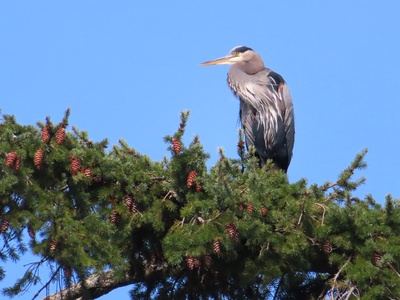
Grey Heron
A large, majestic wading bird with long legs, a dagger-like bill, and grey, black, and white plumage. It can be seen standing motionless in shallow water, patiently waiting to spear a fish, or flying overhead with slow, powerful wingbeats.
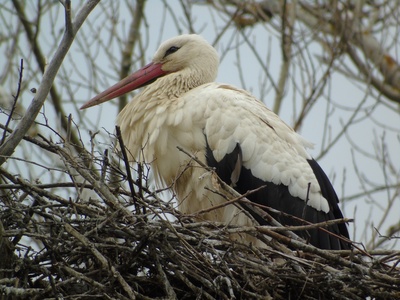
White Stork
An iconic, large white bird with black flight feathers, a long red bill, and long red legs. Famous for nesting on rooftops and chimneys, it’s a welcome sign of spring. Its population in Sweden is small but a subject of conservation efforts.
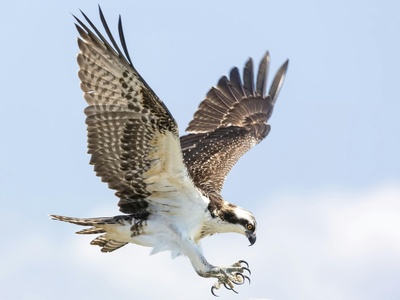
Osprey
A magnificent fish-eating bird of prey with long, angled wings and a distinctively patterned head. It can be seen soaring over water before dramatically plunging feet-first to snatch fish from near the surface. A true symbol of wild, clean waters.
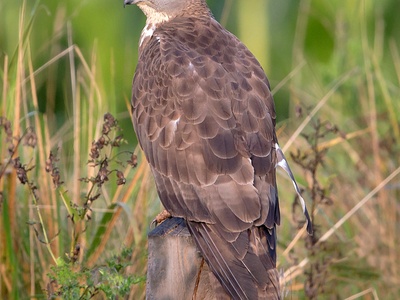
European Honey Buzzard
A medium-sized raptor that resembles a Common Buzzard but has a more slender head and neck. It specializes in feeding on the larvae of wasps and bees, excavating their nests from the ground. It’s a long-distance migrant, wintering in Africa.
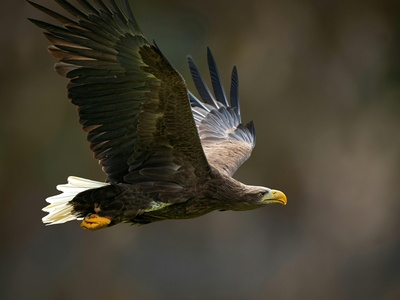
White-tailed Eagle
A massive bird of prey with broad “barn door” wings, a huge yellow bill, and a distinctive white tail in adults. After near extinction, this impressive eagle has made a spectacular comeback and is now a common sight soaring over Swedish waters.
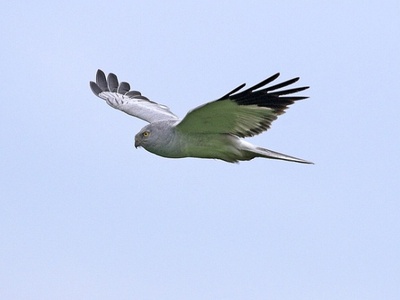
Hen Harrier
A slender, elegant raptor that glides low over the ground with its wings held in a shallow V-shape. The male is a pale, ghostly grey, while the female is brown and streaked with a prominent white rump patch.
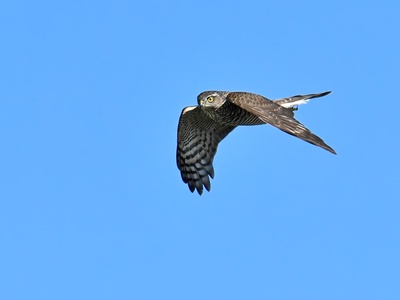
Eurasian Sparrowhawk
A small, agile hawk specializing in hunting small birds. It has short, broad wings and a long tail, allowing it to dash through dense vegetation. The male has a blue-grey back and barred reddish underparts, while the female is larger and browner.
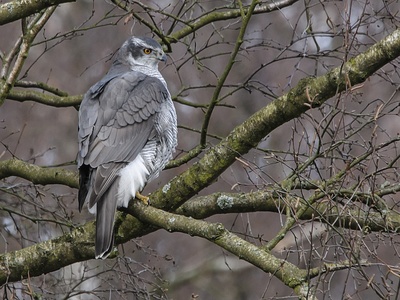
Northern Goshawk
A large, powerful version of the Sparrowhawk, a fierce hunter of birds and mammals. It is a robust hawk with a fierce expression, prominent white eyebrow, and finely barred underparts. It’s a shy bird, often staying hidden within its forest territory.
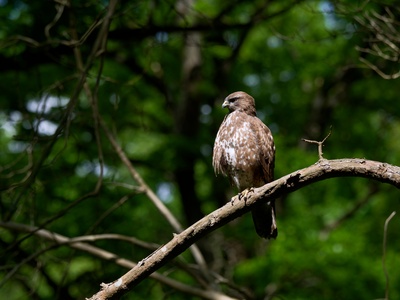
Common Buzzard
Sweden’s most common bird of prey, often seen soaring in lazy circles high in the sky or perched on fence posts. Its plumage is notoriously variable, ranging from dark brown to almost white, but its mewing call is a familiar sound.
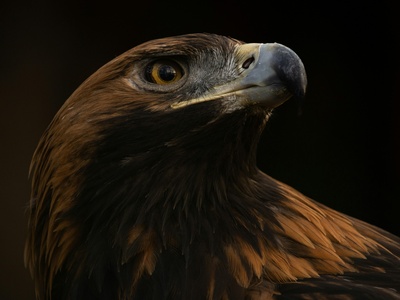
Golden Eagle
A magnificent and powerful eagle of wild, open landscapes. It is a large, dark brown raptor with a golden-sheened nape. This apex predator soars on long, broad wings, hunting for mammals like hares and even young reindeer.
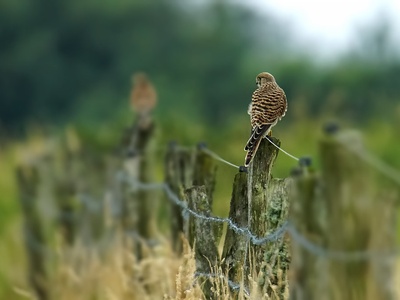
Common Kestrel
A small, graceful falcon famous for its ability to hover in one spot while searching for prey. The male has a grey head and a reddish-brown back, while the female is more uniformly brown. Often seen along roadsides, hunting for voles.
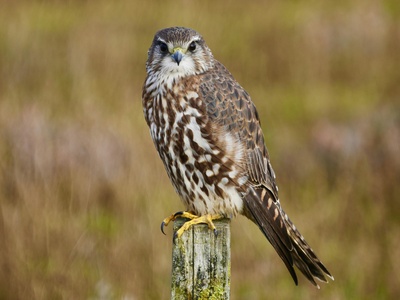
Merlin
Europe’s smallest falcon, a compact and incredibly fast predator that hunts small birds in high-speed chases. The male is a handsome blue-grey above, while the female is a darker brown. It’s a bird of wild, open spaces.
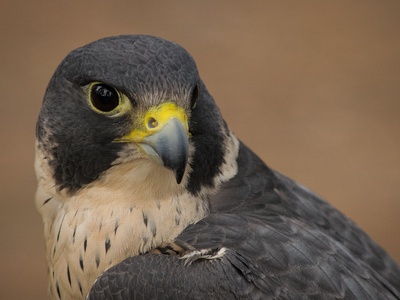
Peregrine Falcon
The fastest animal on the planet, capable of reaching incredible speeds in its hunting stoop. A powerful falcon with a dark “helmet” and moustache, it preys on medium-sized birds. Conservation efforts have helped its population recover in Sweden.
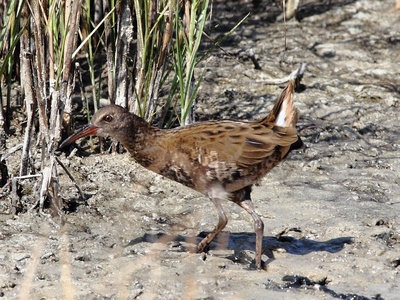
Water Rail
A seldom-seen bird of dense wetlands, more often heard than observed. It has a long, reddish bill and makes a bizarre series of grunts, squeals, and groans, often described as a piglet’s squealing. Its body is laterally compressed to move through reeds.
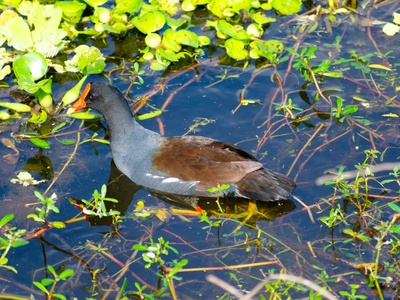
Common Moorhen
A familiar waterbird, dark-bodied with a distinctive red bill tipped with yellow, and a white line along its flanks. It nervously flicks its white undertail as it swims or walks on long, greenish legs. Found in a wide variety of freshwater habitats.
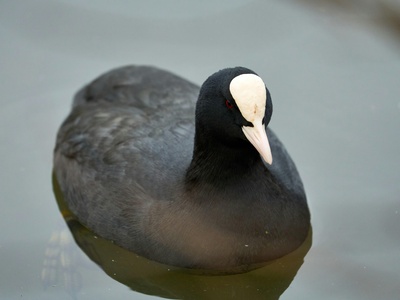
Eurasian Coot
A plump, black waterbird easily identified by its white bill and frontal shield. It can be quite aggressive and noisy, often chasing other birds. It patters across the water’s surface to take flight and dives for aquatic vegetation.
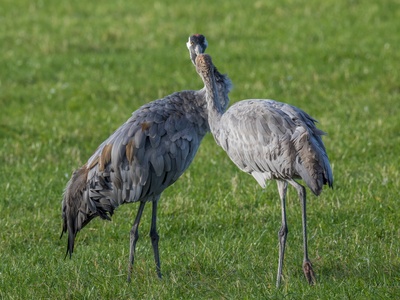
Common Crane
A huge, elegant grey bird with a red patch on its crown. Its bugling calls and “dancing” courtship displays are unforgettable. Thousands gather at staging grounds like Lake Hornborga in spring, a world-famous natural spectacle.
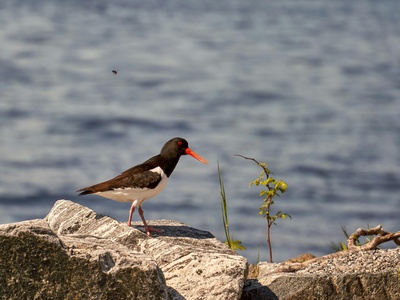
Eurasian Oystercatcher
A large, noisy, and conspicuous black-and-white wader with a long, bright orange-red bill and pink legs. Its loud, piping calls are a characteristic sound of the shoreline. It uses its strong bill to pry open mussels and other shellfish.
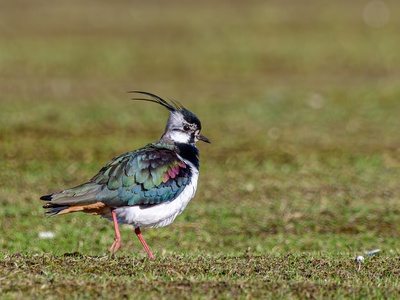
Northern Lapwing
An unmistakable and charismatic wader with iridescent, dark green plumage, a long wispy crest, and broad, rounded wings. Its tumbling, acrobatic display flight and wheezy “pee-wit” call are a classic sign of spring in the agricultural landscape.
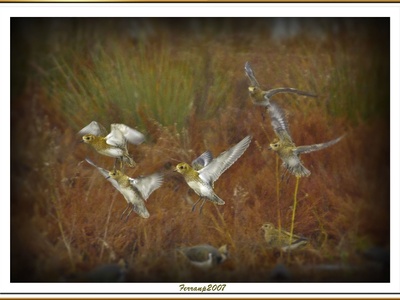
Eurasian Golden Plover
A beautifully spangled, golden-brown wader. In summer, it has a contrasting black face and belly. Its haunting, melancholic, single-note whistle is a classic sound of the vast, open expanses of the Swedish mountains and moorlands.
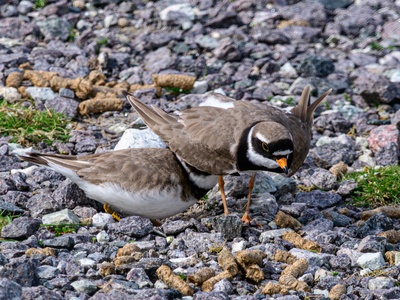
Ringed Plover
A small, dumpy wader with a distinct single black breast band, an orange bill with a black tip, and orange legs. It is known for its “broken-wing” display to lure predators away from its nest. Often seen running in short bursts along beaches.
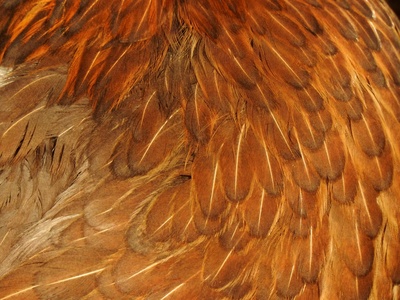
Eurasian Woodcock
A master of camouflage, this plump, secretive wader has intricate dead-leaf-patterned plumage. It is largely nocturnal, but best known for its strange, crepuscular display flight, called “roding,” where males fly over their territory making croaking and whistling sounds.
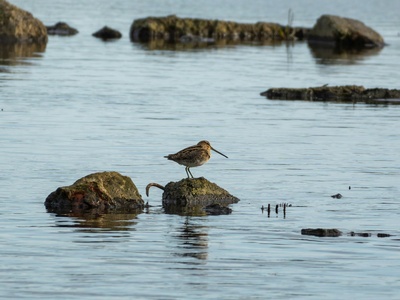
Common Snipe
A medium-sized wader with a very long, straight bill and cryptic brown plumage. Famous for its aerial display where it dives through the air, causing its outer tail feathers to vibrate and produce a unique, eerie, drumming or bleating sound.
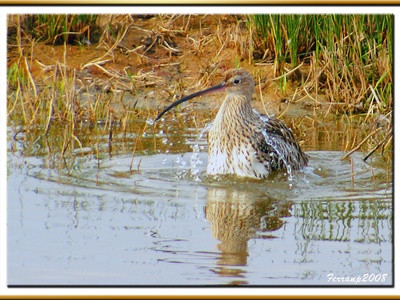
Eurasian Curlew
Europe’s largest wader, instantly recognizable by its immensely long, downcurved bill and haunting, bubbling call. This evocative sound is a feature of open, wild landscapes, but sadly, the species is in steep decline and is a conservation priority.
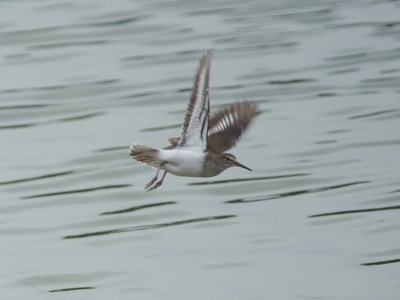
Common Sandpiper
A small, energetic wader with olive-brown upperparts and clean white underparts. It is characterized by its constant “teetering” or bobbing of its rear body. When flushed, it flies low over the water with distinctive stiff, shallow wingbeats.
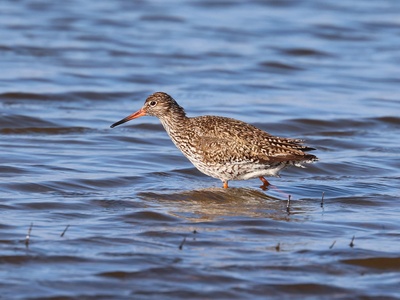
Common Redshank
A noisy and alert medium-sized wader, easily identified by its long, bright red legs. It has a mottled brown back and a straight bill with a reddish base. Its loud, yodelling calls often serve as an alarm for other birds.
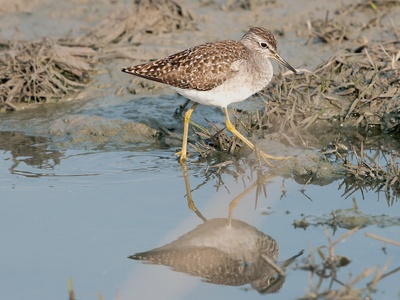
Wood Sandpiper
An elegant, graceful wader with spangled upperparts, a prominent white eyebrow, and long, yellowish legs. It is a very active feeder, and its sharp, three-note call is a characteristic sound of northern wetlands during the summer.
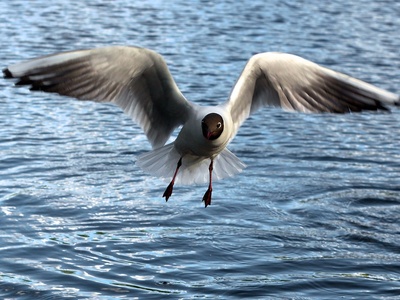
Black-headed Gull
The most common gull in much of Sweden, recognized in summer by its chocolate-brown (not black) hood. It is a noisy, adaptable, and sociable bird, often seen far inland on fields and in urban parks, as well as coastal areas.
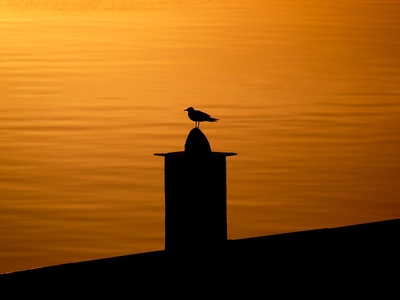
Common Gull
A medium-sized, gentle-looking gull with a rounded head, greenish-yellow legs, and a relatively thin bill. It is less of a scavenger than its larger relatives and is a familiar sight in coastal towns, farmland, and along lakeshores.
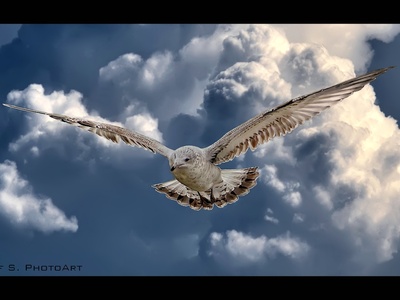
Herring Gull
A large, robust gull with a pale grey back, pink legs, and a powerful yellow bill with a red spot. This intelligent and opportunistic bird is a quintessential feature of coastal areas, known for its loud, laughing calls.
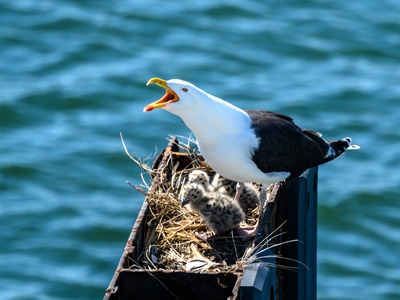
Great Black-backed Gull
The world’s largest gull, a powerful and imposing bird with a dark slate-grey back, massive yellow bill, and pink legs. It is an apex predator and scavenger, capable of overpowering other seabirds and stealing their food.
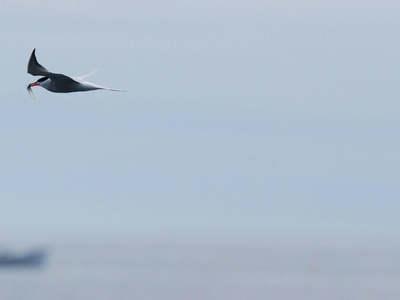
Common Tern
A graceful, slender seabird with long, narrow wings, a forked tail, and a sharp black cap. It is an agile flyer, seen hovering over the water before plunge-diving for small fish. The bill is reddish-orange with a black tip.
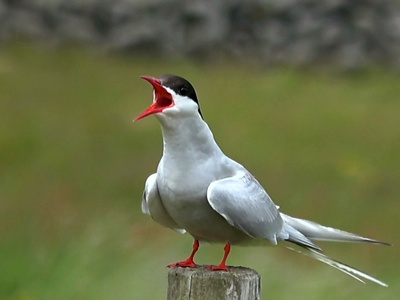
Arctic Tern
Very similar to the Common Tern, but with a blood-red bill and slightly shorter legs. This species is famous for undertaking the longest migration of any animal, travelling from its Arctic breeding grounds to the Antarctic for the winter.
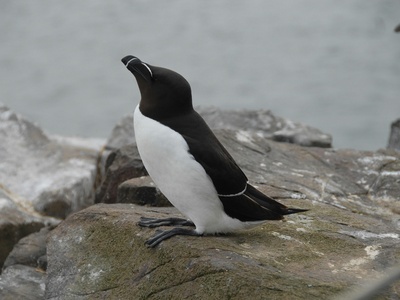
Razorbill
A classic auk, looking like a “seabird penguin” with its black-and-white plumage and thick, blunt bill. It nests on rocky ledges, often in the company of guillemots, and is an expert diver, “flying” underwater to catch fish.
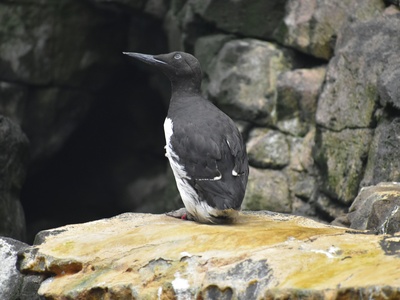
Common Guillemot
A large auk with dark brown and white plumage and a thin, pointed bill. It nests in huge, noisy, and tightly packed “seabird cities” on cliff ledges. The single pear-shaped egg is laid directly on the bare rock.
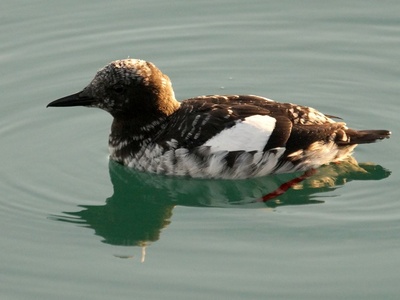
Black Guillemot
A medium-sized auk that is entirely black in summer, except for large, conspicuous white wing patches. A key identifying feature is its bright red feet. It is less colonial than its relatives, often nesting in rock crevices or under boulders.
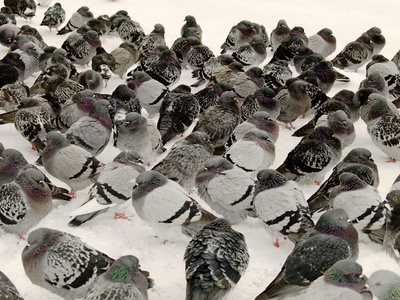
Rock Dove / Feral Pigeon
The familiar city pigeon, descended from wild Rock Doves. Its plumage is highly variable, ranging from the ancestral grey with iridescent neck and double wing-bars to all-white, pied, or dark morphs. A ubiquitous sight in all urban environments.
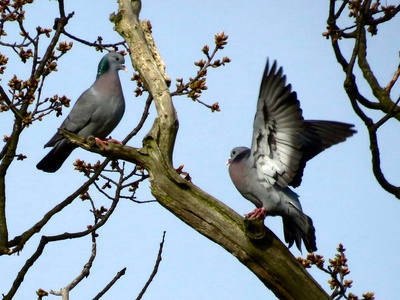
Stock Dove
A slightly smaller and darker pigeon than the Woodpigeon, lacking the white neck and wing patches. It is a cavity nester, often using old woodpecker holes or nest boxes. Its call is a repetitive, grunting “ooo-uu-ooo.”
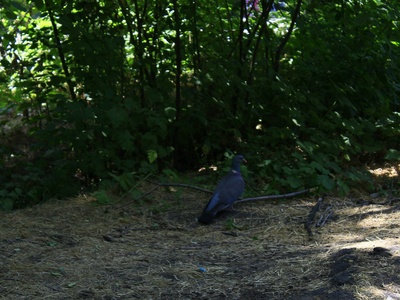
Common Wood Pigeon
The largest and most common pigeon in Sweden. It is a portly, grey bird with a distinctive white patch on its neck and a white band on its wings, very visible in flight. Its cooing, five-note call is a familiar sound of spring and summer.
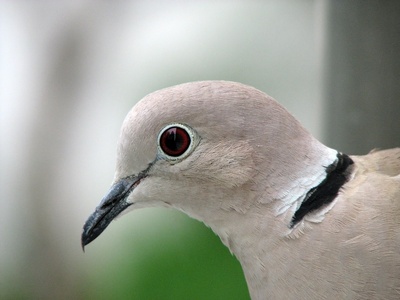
Eurasian Collared Dove
A pale, sandy-grey dove with a narrow black half-collar on its neck. This species underwent a dramatic range expansion across Europe in the 20th century and is now a common resident in human-dominated landscapes. Its call is a monotonous, three-note coo.
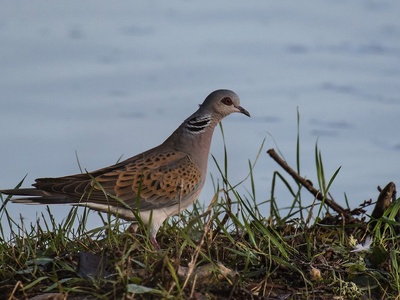
European Turtle Dove
A small, delicate dove with a beautifully intricate, scaled pattern on its wings and a striped neck patch. Its gentle, purring call was once a classic sound of summer, but the species has suffered a catastrophic decline and is now very rare.
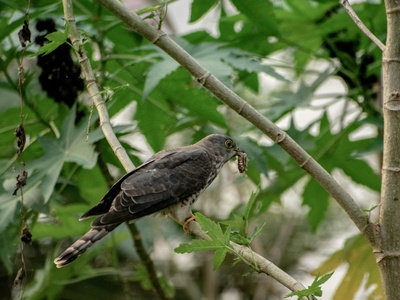
Common Cuckoo
Famous for its iconic “cu-ckoo” call and its brood-parasitic behaviour of laying eggs in the nests of other birds. It’s a slender, hawk-like bird that is more often heard than seen. The call is one of the most celebrated signs of spring.
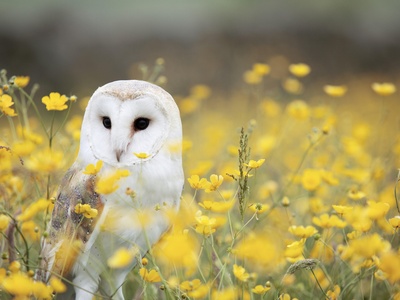
Barn Owl
A ghostly, pale owl with a heart-shaped facial disc, dark eyes, and golden-buff upperparts. Strictly nocturnal, it hunts for small mammals over open country. Its eerie, screeching call, rather than a hoot, can be quite unsettling.
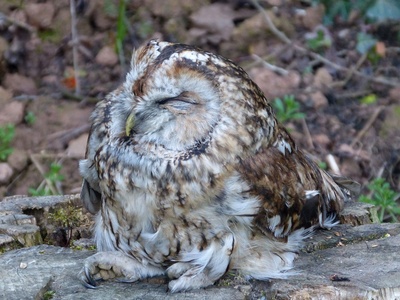
Tawny Owl
A medium-sized, stocky owl with dark eyes and a rounded head. It has a familiar, quavering “hoo-hoo-hooo” call that is a classic nocturnal sound. It is highly adaptable, often living in surprisingly urban areas.
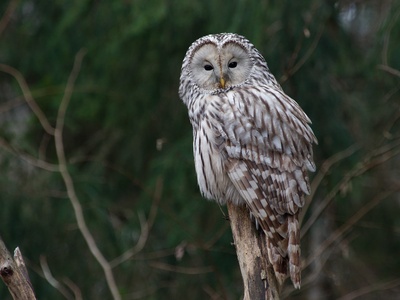
Ural Owl
A large, powerful, and pale grey owl with a long tail and small, dark eyes. It is a formidable predator of the northern forests. It can be very aggressive near its nest, and its call is a deep, rhythmic “hoo-hoo hoo-hoo.”
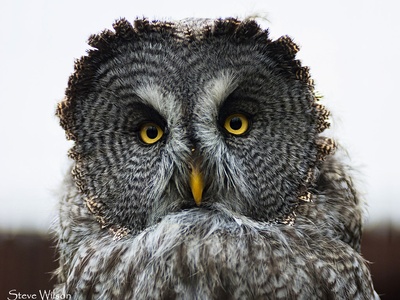
Great Grey Owl
Sweden’s largest owl by size, an impressive bird with a huge, concentrically ringed facial disc, small yellow eyes, and a long tail. It hunts voles by plunging into deep snow. A mythical and highly sought-after species for birdwatchers.
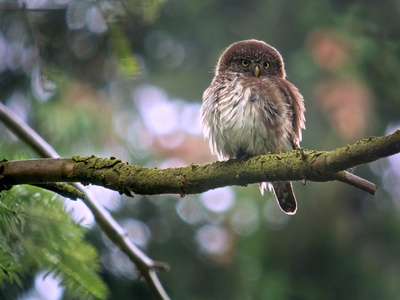
Eurasian Pygmy Owl
Europe’s smallest owl, no bigger than a starling. It is surprisingly bold and often active during the day. Its call is a series of repeated, whistling “poo” notes, similar to a Bullfinch. It hunts small birds and voles.
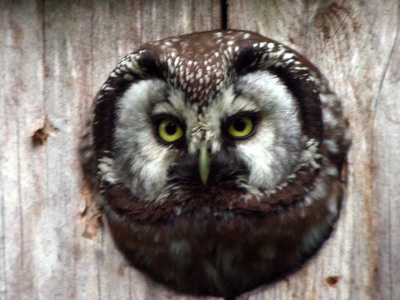
Boreal (Tengmalm’s) Owl
A small, secretive nocturnal owl with a large, square-ish head, white-spotted brown plumage, and piercing yellow eyes set in prominent facial discs. Its call is a rapid, accelerating series of “poo-poo-poo” notes, a classic sound of the taiga night.
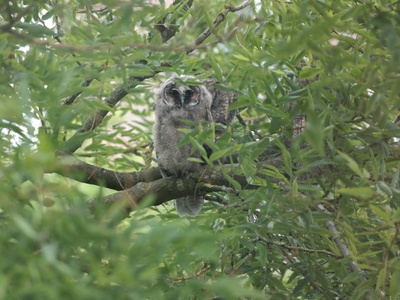
Long-eared Owl
A slender, medium-sized owl with long, prominent ear tufts (which are not actually ears) and bright orange eyes. It is strictly nocturnal and very secretive, but in winter, they sometimes gather in communal roosts, offering a rare chance to see them.
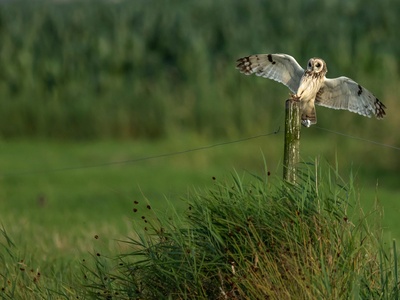
Short-eared Owl
A medium-sized owl of open country, often seen hunting during the day, especially at dawn and dusk. It flies with deep, moth-like wingbeats. It has short, often invisible ear-tufts and staring yellow eyes set off by dark patches.
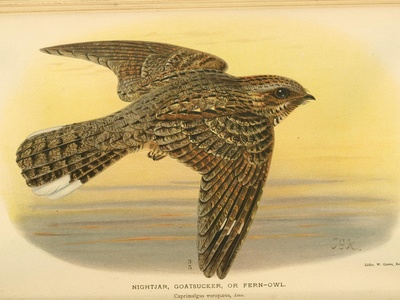
European Nightjar
A bizarre, nocturnal bird with wonderfully cryptic, bark-like camouflage. It is best known for its strange, churring song, a continuous, mechanical trill performed at dusk and dawn. In flight, it is silent and moth-like.
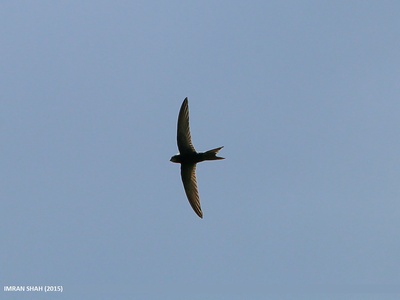
Common Swift
The ultimate aerialist, spending almost its entire life on the wing. A dark, sickle-winged bird that dashes through the sky with incredible speed and agility, often giving high-pitched, screaming calls. A true sign of high summer.
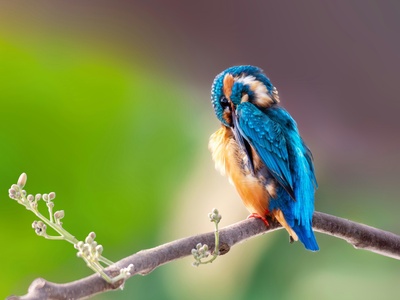
Common Kingfisher
A jewel-like bird, small and stunningly beautiful with its electric-blue back and bright orange underparts. It is seen as a flash of blue as it darts low over the water, hunting for small fish from a perch.
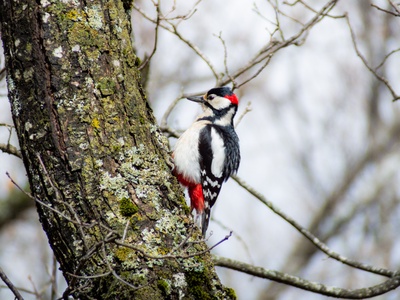
Great Spotted Woodpecker
The most common woodpecker in Sweden, a striking black-and-white bird with a bold red patch under its tail. Its loud, explosive “kick” call and its rapid, drumming territorial signal are familiar sounds in forests, parks, and gardens.
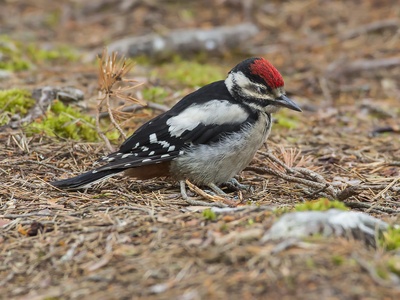
Lesser Spotted Woodpecker
A tiny, sparrow-sized woodpecker, patterned in black and white like its larger relative but lacking any red under the tail. It is often found high in the canopy of trees and has a much quieter, less powerful drum.
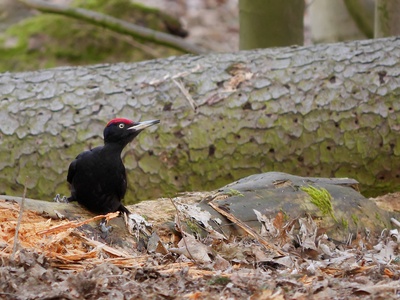
Black Woodpecker
Europe’s largest woodpecker, a huge, entirely black bird with a striking fiery-red crest (larger in males). Its loud, ringing calls and powerful, slow drumming echo through the forest. It excavates huge nesting holes that benefit many other species.
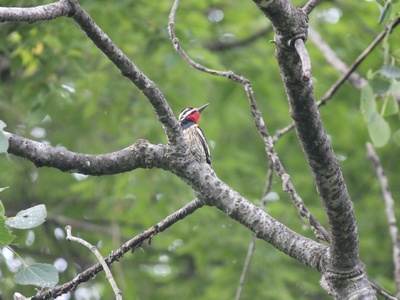
Eurasian Green Woodpecker
A large, colorful woodpecker with a green back, yellow rump, and a red crown. It spends much of its time on the ground, feeding on ants. It doesn’t drum often but is known for its loud, laughing or “yaffling” call.
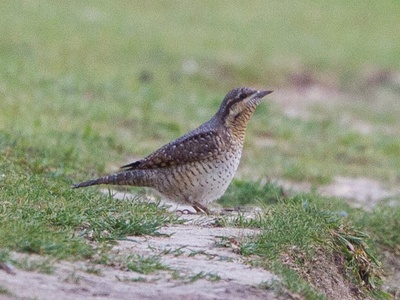
Eurasian Wryneck
A strange, cryptic little woodpecker relative that looks more like a nightjar. It is named for its ability to turn its head almost 180 degrees. It nests in cavities but cannot excavate its own, and it feeds primarily on ants.
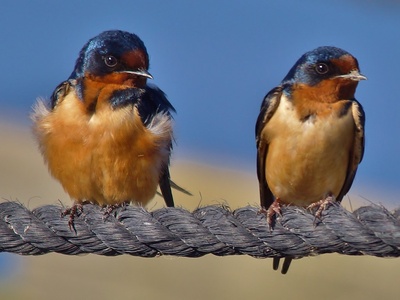
Barn Swallow
An elegant and agile flyer with glossy blue-black upperparts, a reddish-brown throat, and long tail streamers. A classic sign of summer, it builds a mud-cup nest in barns and outbuildings, swooping low over fields to catch insects.
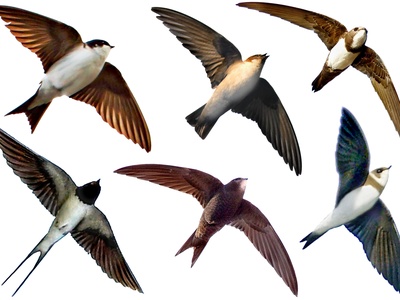
House Martin
A small, sociable swallow with glossy blue-black upperparts and a contrasting pure white rump and underparts. It builds enclosed mud nests under the eaves of buildings, often in large colonies. It is constantly twittering as it flies.
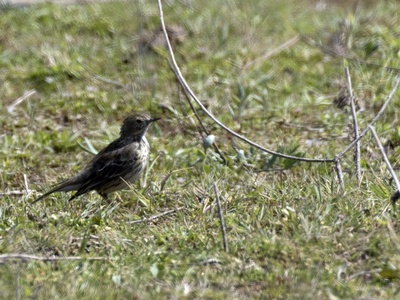
Meadow Pipit
One of Sweden’s most numerous birds, a small, streaky brown “LBJ” (little brown job). It has a weak, wispy call and a simple, parachuting song flight. It is the primary host for the Common Cuckoo in many areas.
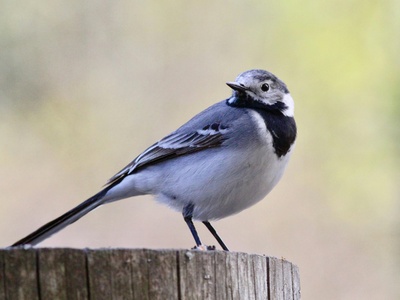
White Wagtail
An elegant, slender black, white, and grey bird instantly recognizable by its constantly wagging long tail. It is a familiar sight in car parks, on rooftops, and near water, where it actively chases insects on the ground.
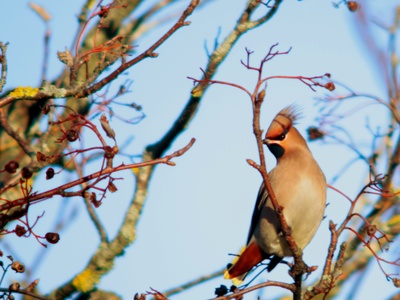
Bohemian Waxwing
A stunning, starling-sized bird with a silky, pinkish-brown plumage, a prominent crest, and unique red, waxy tips on its wing feathers. In winter, large, nomadic flocks can descend on berry-laden trees, their trilling calls filling the air.
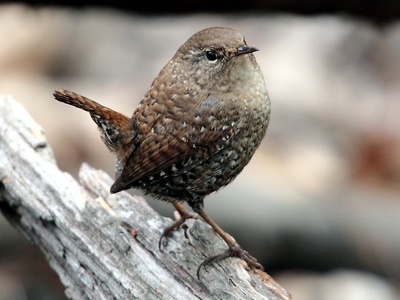
Winter Wren
A tiny, plump, and hyperactive brown bird, often holding its short tail cocked upright. Despite its size, it has an astonishingly loud and complex, bubbling song. It scurries mouse-like through the undergrowth, hunting for insects.
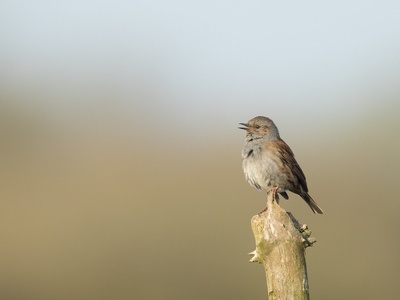
Dunnock
A quiet, unobtrusive little bird often mistaken for a sparrow. It has a subtle, streaky brown plumage with a grey head and breast. It typically forages on the ground with a shuffling gait and has a surprisingly complex social life.
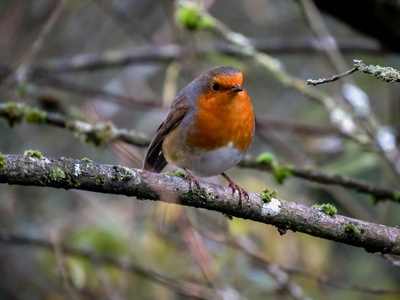
Eurasian Robin
A small, plump bird instantly recognizable by its bright orange-red face and breast. Known for its beautiful, warbling song, often heard year-round. It’s a bold and curious bird, frequently seen hopping on the ground in search of insects.
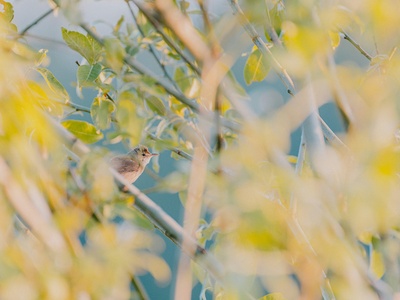
Thrush Nightingale
A plain, brown bird that is visually unremarkable but possesses one of the most powerful and spectacular songs in Europe. Its rich, explosive, and varied song is delivered with incredible volume, mainly at night, from dense, hidden cover.
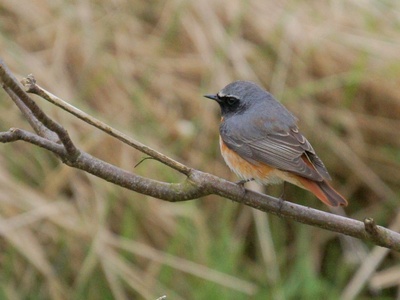
Common Redstart
A handsome little bird, the male has a slate-grey back, black face, white forehead, and a bright orange-rufous breast and tail. The constantly quivering, rusty-red tail is a key feature for both sexes. It is a cavity-nesting insectivore.
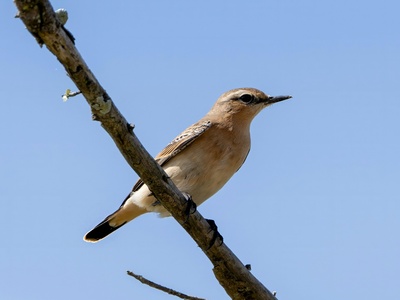
Northern Wheatear
A charismatic bird of open country, recognized by its distinctive white rump, which flashes as it flies away. The male in summer is a smart grey, black, and buff. It is often seen perched on rocks or walls, bobbing and flicking its tail.
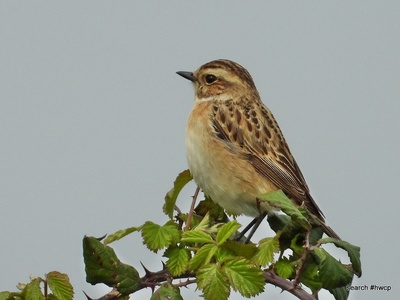
Whinchat
A small, stocky chat with a prominent white eyestripe. It likes to perch conspicuously on fence posts or tall stalks in its grassy habitat. Its song is a scratchy, hurried warble. A long-distance migrant, wintering in Africa.
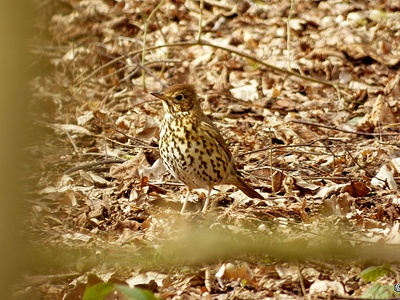
Song Thrush
A medium-sized thrush, warm brown above and heavily spotted below. It is famed for its beautiful, loud, and repetitive song, where it delivers short, fluty phrases, each repeated two or three times. It famously smashes snail shells on an “anvil” stone.
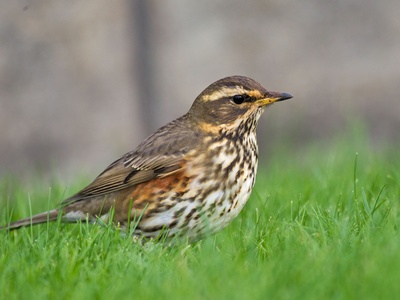
Redwing
A small thrush with a bold, creamy-white stripe above the eye and distinctive rusty-red flanks and underwing patches, visible in flight. It has a beautiful, fluting song and is often seen in large flocks during migration.
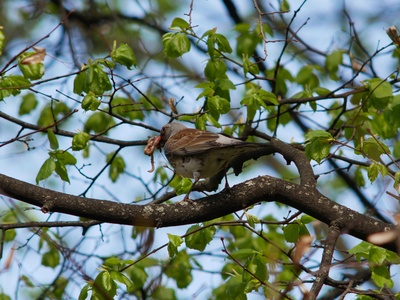
Fieldfare
A large, handsome, and noisy thrush with a grey head and rump, brown back, and a heavily spotted breast. They are highly social, breeding in loose colonies and often seen in large, chattering flocks, especially in winter.
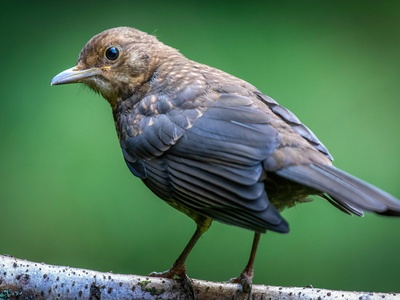
Eurasian Blackbird
One of Sweden’s most familiar birds. The male is a sleek, glossy black with a bright orange-yellow bill and eye-ring. The female is a uniform dark brown. Its rich, melodious song is a cherished feature of dawns and dusks.
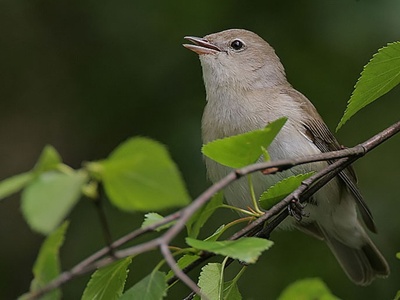
Garden Warbler
A very plain, uniformly greyish-brown warbler with no distinguishing features, making it a notorious identification challenge. It is best identified by its song: a beautiful, long, fast-paced, and rambling musical warble delivered from deep cover.
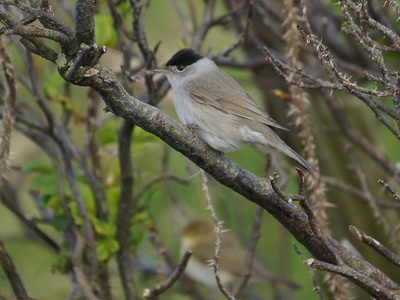
Eurasian Blackcap
The male is a neat greyish bird with a distinctive black cap, while the female’s cap is reddish-brown. It has a beautiful, rich, and fluty song that starts as a chatter before rising to a crescendo. One of Sweden’s most common summer visitors.
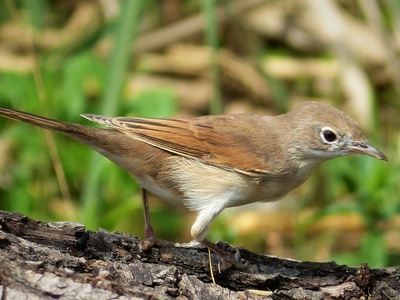
Common Whitethroat
A bustling, energetic warbler, often seen delivering its scratchy, hurried song from a prominent perch before launching into a short, dancing song flight. The male has a grey head, white throat, and rusty-brown tones on the wings.
